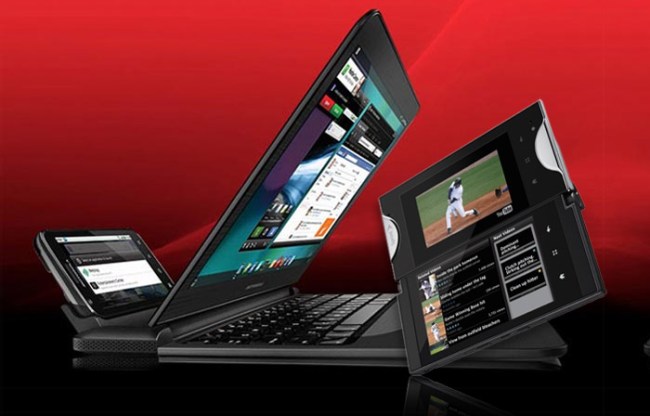
We’re sick of the iPhone, too. Despite antenna issues, Draconian app store rules and an engineered inability to run Flash content, Apple’s flagship smartphone has done to the smartphone market what the Romans once did to Europe.
The good news: Now a marauding horde of smartphone manufacturers under the flag of Google Android are back for their turf, and they’re not just cobbling together iPhone-wannabes anymore. From the world’s first dual-screen smartphone to a phone with all the processing power of a laptop – and a dock that turns it into one – these next-generation smartphones will all bring something totally unique to the battlefield when they arrive soon.
 LG Optimus 3D
LG Optimus 3D
The pitch: The 3D craze that has been raging on televisions for the last year finally reaches the small screen with the world’s first 3D smartphone. No glasses needed, just gaze into the 4.3-inch LCD and 3D content comes to life. As if that weren’t enough, dual 5-megapixel cameras in the rear allow you to capture 3D video in 1080p, for playback right on the phone, or a 3D TV via HDMI.
Skeptic’s slant: 3D seems questionable enough on a television, on a phone it’s almost comically frivolous. Adding depth to a screen you have to touch could actually make the phone harder to use, and experience also tells us that viewing 3D content on a screen this small typically lacks the punch that has made 3D a hot seller in theaters.
Availability: LG only announced the Optimus 3D on Monday at Mobile World Congress, so both price and availability remain a question mark for the time being.

 Motorola Atrix 4G
Motorola Atrix 4G
The pitch: Plug Motorola’s Atrix 4G into its optional dock and the humble smartphone becomes a 13-inch notebook, giving you a full-size screen, keyboard, and even a separate battery to charge the phone as it sits.
Skeptic’s slant: The optional laptop dock will cost you $500, and because it doesn’t run Windows 7, it does a lot less than a $350 netbook would.
Availability: AT&T will open the Atrix 4G for preorder on February 13, and begin shipping units March 6 or earlier. The phone itself runs for $199 with a two-year contract.

 Kyocera Echo
Kyocera Echo
The pitch: When the Echo’s little 3.5-inch touchscreen starts to feel a little cramped, slide it apart and a second identical screen rises up to meet it, providing a combined 4.7 inches of glowing LCD. The two screens allow you to browse side-by-side websites, read an e-mail in one screen while you reply in another, and even play games like The Sims where one screen acts as a controller, similar to the Nintendo DS.
Skeptic’s slant: Not many apps will work with the dual-screen functionality right off the bat, and running two screens at once will cost you big time on battery life.
Availability: Sprint will offer the Echo for preorder within the next few weeks for $199 with contract, but it won’t begin shipping until spring.

 Samsung Infuse 4G
Samsung Infuse 4G
The pitch: With a whopping 4.5-inch Super AMOLED Plus Screen and a body as deep as a pencil, the Infuse 4G will be both the largest and thinnest phone in AT&T’s portfolio. Thanks to HSPA+ 4G, it will also be one of the fastest on the network. And did we mention it shoots 1080p video?
Skeptic’s slant: Sprint’s 4.3-inch EVO 4G already dropped jaws (and stretched pockets) with its screen size. Is a 4.5-inch screen on a phone really practical?
Availability: Samsung’s Infuse 4G will arrive in the second quarter of 2011 exclusively on AT&T.

 HTC ThunderBolt
HTC ThunderBolt
The pitch: Verizon’s first 4G LTE handset will also be the first to support Skype-to-Skype video – with or without Wi-Fi. No more clambering around to find a hotspot when you want to videoconference, and being limited to friends with Facetime. It packs the same jumbo-sized 4.3-inch LCD and 8-megapixel camera as Sprint’s EVO 4G.
Skeptic’s slant: It’s warmed-over EVO 4G on Verizon. On second thought, maybe that’s not such a bad thing after all.
Availability: Rumors once pointed to a Valentine’s Day release, but the latest leaked documents now show “no ETA.”

 LG Optimus 2x
LG Optimus 2x
The pitch: Two is always better than one, which makes the LG Optimus 2x, the world’s first dual-core smartphone, quite a catch. Nvidia’s hotrod Tegra 2 processor enables rich gaming, fluid multitasking and even 1080p video capture. With the HDMI output, you can hook it up to your TV and watch movies on the big screen, in 1080p.
Skeptic’s slant: Apps have to be specially developed to take advantage of the dual-core design, which means few of them will really tap into what the Optimus 2x can do at launch.
Availability: Rumors have the Optimus 2x launching in late March or early April, but LG will launch the Optimus 2x as a “world phone.” That means it won’t be showing up at the store down the street with a hefty subsidy like phones that carriers officially adopt – you’ll have to snag it online, without a contract, for a hefty sum.









